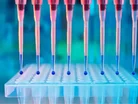Breakthrough Study Prints 3D Stem Cells

The future of donor organs could lie in 3D printing, and that reality is a little closer now that scientists have developed the first printer for embryonic human stem cells.
Researchers from the University of Edinburgh, Scotland have created a cell printer that produces living embryonic stem cells. According to reports, the printer is capable of printing uniform-size droplets of cells, gently enough to keep them alive and to maintain their ability to develop into different cell types.
The new printing method could be used to develop 3D human tissues for testing new drugs, to create donor organs or ultimately print cells directly inside the body.
“Human embryonic stem cells (hESCs) are obtained from human embryos and can develop into any cell type in an adult person, from brain tissue to muscle to bone. This attribute makes them ideal for use in regenerative medicine — repairing, replacing and regenerating damaged cells, tissues or organs,” reads a report published on LiveScience.com.
“In a lab dish, hESCs can be placed in a solution that contains the biological cues that tell the cells to develop into specific tissue types, a process called differentiation. The process starts with the cells forming what are called “embryoid bodies”. Cell printers offer a means of producing embryoid bodies of a defined size and shape.”

The 3D Printer
The cell printer used in the study conducted at the University of Edinburgh was made from a modified CNC machine (a computer controlled machining tool) outfitted with two bio-ink dispensers, one containing stem cells in a nutrient-rich soup called cell medium and another containing just the medium.
The cells were printed onto a dish and tests revealed that more than 95 percent of the cells were still alive 24 hours after being printed, suggesting they had not been killed by the printing process. More than 89 percent of the cells were still alive three days later, and also tested positive for a marker of their pluripotency — their potential to develop into different cell types.
Biomedical engineer Utkan Demirci, of Harvard University Medical School and Brigham and Women's Hospital, has done pioneering work in printing cells, and thinks the new study is taking it in an exciting direction. “This technology could be really good for high-throughput drug testing,” Demirci told LiveScience.com. One can build mini-tissues from the bottom up, using a repeatable, reliable method, he said. Building whole organs is the long-term goal, though Demirci cautioned that it “may be quite far from where we are today.”



